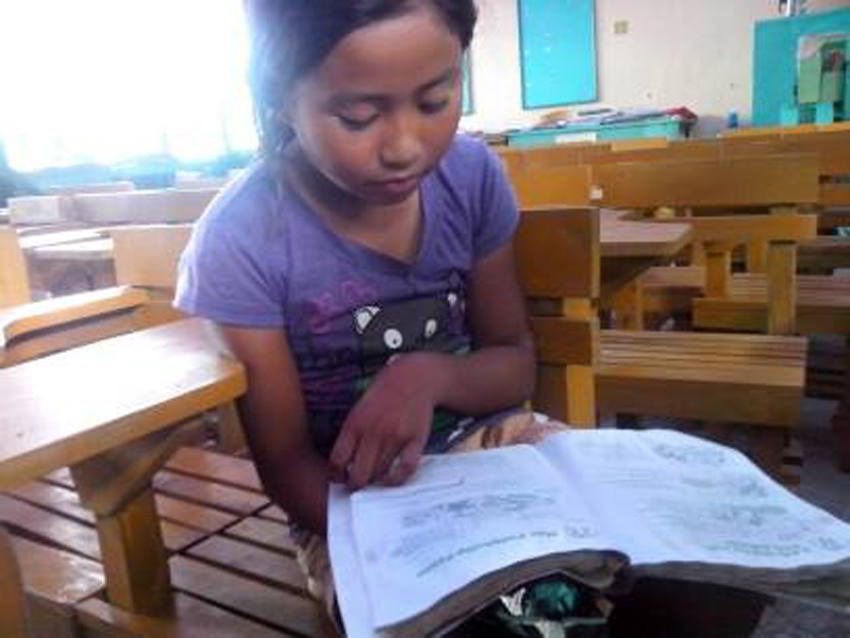
Janina Fe Quiroz, reads her favorite science book inside a classroom at the Libertad Elementary School. (CDN PHOTO/MICHELLE JOY PADAYHAG)
Libertad, Ormoc City—Ten-year-old Janina Fe Quiroz has two wishes for Christmas.
First, she wanted her family to recover from the devastation caused by supertyphoon Yolanda (international name: Haiyan). The second is for her school to be repaired before the year ends.
While quite a tall order, Quiroz is determined to do everything she can to make it a reality.
Last Nov. 27, she helped the Australian Defense Force clean up the Libertad Elementary School, one of many structures damaged by Yolanda.
“Nanilhig me kauban among teacher kay ganahan na jud me mabalik among klase (I went with my teacher because I am eager to return to class),” Quiroz told Cebu Daily News.
Recovery plan
Quiroz’s plight along with millions in Leyte province were seen firsthand by UN Secretary General Ban Ki-moon who urged the international community yesterday to ramp up aid for the Philippines’ typhoon reconstruction.
“We must not allow this to be another forgotten crisis,” said Ban, who met with key ambassadors stationed in Manila at the end of his three-day visit and urged donor countries to provide more aid in the aftermath of supertyphoon Yolanda.
Yolanda tore through central Philippines last Nov. 8, killing at least 6,100 people and leaving around 1,800 missing.
Entire villages (barangays) were flattened by Yolanda’s ferocious winds and the tsunami-like storm surge that damaged or swept away more than a million homes and injured 27,000 people.
The UN is raising $791 million for a yearlong recovery plan.
Moved
The national government has separately launched an $8.17 billion four-year reconstruction drive.
Ban told reporters that the UN stands firmly with the country’s government and leadership in improving preparedness and resilience to natural disasters.
He said he visited the country to show solidarity with the government and Filipinos, and was deeply moved and inspired by his visit Saturday to Tacloban city, one of the hardest-hit by the typhoon.
“People are working hard to recover,” he said. “We must not allow this to be another forgotten crisis.”
At the onset of the supertyphoon Quiroz, a Grade 5 student, was told by her mother to secure her clothes.
“I secured my notebooks first because I was expecting that after the storm, classes would resume,” she said.
Quiroz stuffed her 12 notebooks inside a plastic envelope and waited with her family for supertyphoon Yolanda’s gale-force winds and rain to subside.
Uprooted
Two days after the storm, her home was in shambles and all she found was her plastic envelope stuffed with notebooks.
Try as she could, she was unable to find her school uniforms, bag and two pairs of shoes.
“I only have two skirts left after the storm, I searched for my two pairs of shoes but only one pair was left. I cannot find the bag given to me by my father,” a teary-eyed Quiroz said.
Quiroz’s father works in a merchandising store while her mother is a housewife.
When classes resumed last Monday, Quiroz and her classmates had to make do with makeshift classrooms .
“Karon mo uli na lang ko sa amoa adto mo kaon. Wala naman me kapasilungan (We had to go home to eat lunch. There are no more trees to provide us shade),” Quiroz said, adding that all the trees were uprooted by the typhoon.
Despite these conditions, Quiroz, an honor student, is determined to finish her studies even if her family had to conserve the use of their flashlights to save on batteries.
“I want to become a computer engineer someday,” she added.
Happy, resilient
Capt. Shad Marsh of the Australian Joint Task Force’s Civil Military Cooperation (CIMIC) witnessed the resilience and courage of Quiroz and the 16 schools they were helping in Ormoc.
“There was a full cooperation with nongovernment organizations, teachers, students and the community. Those schools need attention. Children need to go back to school,” he said.
About 15,000 students and 15 teachers managed to attend class following the school repairs made by the 50-strong Australian task force which took two weeks and three days.
“I will surely miss the Filipino people because they are happy and resilient,” Marsh said.
More needs to be done for the supertyphoon-hit areas to stand on their feet, Ban said.
Build better
He urged “all donors to add to their already generous response so that we can help communities to build back better and safer.”
Foreign Secretary Albert del Rosario said the supertyphoon demonstrates the threat of extreme weather patterns that may be the new normal due to climate change.
“The Philippines calls on all nations, rich and poor, to come together to confront this challenge,” del Rosario said.
He said the Philippines will “strongly participate” in Ban’s proposed climate change summit in September next year.
British Ambassador Asif Ahmad, one of the ambassadors who met with Ban, said that the UN chief’s visit “was important to retain international and domestic focus on recovery from the typhoon before attention moves on.”